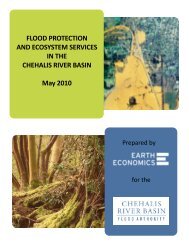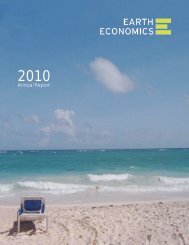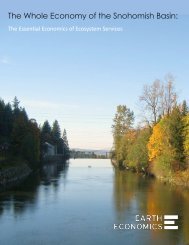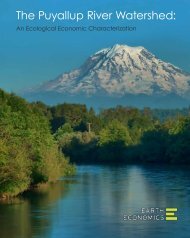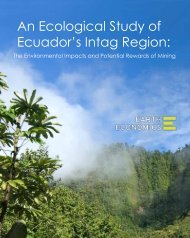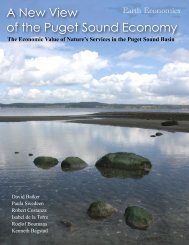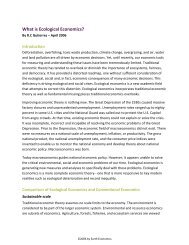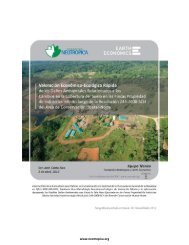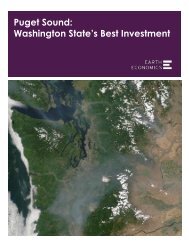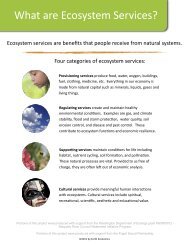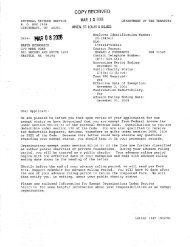The Spot Prawn Fishery: A Status Report - Earth Economics
The Spot Prawn Fishery: A Status Report - Earth Economics
The Spot Prawn Fishery: A Status Report - Earth Economics
You also want an ePaper? Increase the reach of your titles
YUMPU automatically turns print PDFs into web optimized ePapers that Google loves.
<strong>The</strong> <strong>Spot</strong> <strong>Prawn</strong> <strong>Fishery</strong>: A <strong>Status</strong> <strong>Report</strong><br />
<strong>The</strong> Commission of European Communities<br />
recently approached ICES to facilitate a better<br />
understanding of the precautionary principle in<br />
the context of setting annual catch quotas. According<br />
to ICES, reference points or thresholds are one<br />
of the centerpieces of precautionary management.<br />
<strong>The</strong>se thresholds typically are used to identify a<br />
spawning biomass level below which the sustainability<br />
of the stock or species is placed at risk<br />
(Commission of European Communities 2000).<br />
Zhang (1999) explores the idea that managers<br />
can use two distinct types of precautionary reference<br />
points: a management or target reference<br />
point (TRP) and a conservation or limit reference<br />
point (LRP). <strong>The</strong> TRP indicates the exploitation<br />
target for management purposes; the LRP<br />
defines the biological limit of the stock or population<br />
in question. <strong>The</strong> paper describes a number of<br />
different empirical equations and fisheries assessment<br />
models that can be used to derive the reference<br />
points based on the characteristics of the<br />
species and the fishery.<br />
Once the reference points or thresholds are<br />
established, the fishery will need to be frequently<br />
monitored in order to “ensure that the exploitation<br />
pattern does not change” (Boutillier and<br />
Bond 1999b). Within the bounds of these safety<br />
margins or reference points is room for many different<br />
types of management strategies. Managers<br />
must define the environmental, economic, and<br />
sociocultural goals they are seeking to maximize;<br />
e.g., ecosystem health, sustainability, yield by<br />
weight, the economic value of catches, community<br />
stability, jobs, etc. Multi-annual decision-making<br />
regimes can then be established that outline<br />
the guidelines, criteria, and thresholds needed<br />
to sustainably manage a fishery.<br />
1.2 Ensure the Adequacy of Environmental<br />
Information<br />
<strong>The</strong> history of fisheries management reads like<br />
a good novel: crisis, ruin, intrigue, noble aspirations,<br />
“good guys” and “bad guys,” fortunes<br />
won and lost. <strong>The</strong> numbers tell the same tale,<br />
both globally and in the US. According to the<br />
United Nations Food and Agriculture Organization<br />
(FAO 1997), nearly 70% of the world’s fish<br />
stocks are overfished, depleted, or fully exploited.<br />
In the US, almost 50% of the fisheries for which<br />
there are data are overfished or in decline.<br />
<strong>The</strong> crisis in fisheries management does not exist<br />
because of a lack of attempts to manage. In the US,<br />
the National Marine Fisheries Service, in its various<br />
organizational iterations, has been actively managing<br />
and regulating fishing since the 1800s. Collapses<br />
are directly attributable to a lack of ecological<br />
information, a resultant uncertainty in science,<br />
and a failure to manage with precaution due<br />
to these information limits. Scientific and management<br />
uncertainty stems from a number of<br />
sources:<br />
•dearth of information regarding the status of fish<br />
populations<br />
•numerous unknowns regarding ecological<br />
relationships and factors affecting population<br />
abundance and distribution, and the cumulative<br />
effect of these variables on the population or<br />
ecosystem<br />
•unpredictability surrounding the nature, inci-<br />
Our marine economies are whollyowned<br />
subsidiaries of the marine<br />
environment.<strong>The</strong> services and products<br />
provided by the sea secure our<br />
dependence on it. Not only does<br />
the ecological state of the world’s<br />
oceans mandate a higher level of<br />
concern and a greater stewardship<br />
role, but we must also acknowledge<br />
the fact that we are not as removed<br />
from the ocean as we often assume.<br />
“We are, in a sense, soft vessels of<br />
seawater. Seventy percent of our<br />
bodies is water, the same percentage<br />
that covers <strong>Earth</strong>’s surface.We<br />
are wrapped around an ocean within.You<br />
can test this simply enough:<br />
Taste your tears” (Safina 1998, p.<br />
434).<br />
“Recognizing our interrelationship<br />
does not imply notions of some<br />
unreal ocean utopia wherein all<br />
creatures swim at peace” (Safina<br />
1998, p. 440). A sea ethic is not<br />
some new, naïve mythology. Rather,<br />
a sea ethic is a concept that will<br />
allow us to expand the concept of<br />
humanity and the richness of our<br />
human experience.<br />
Such a perspective frees the<br />
mind and opens doors: to a lifetime<br />
of boundless inquiry, to a<br />
wealth of enriching insights and<br />
reflection, to the chance to be<br />
more fully human, to the possibility<br />
of making a meaningful<br />
contribution.<strong>The</strong> only prerequisites<br />
for taking this path are<br />
respectfulness and an extravagant<br />
desire for exploration—<br />
both impulses that build an elevated<br />
sense of vitality and purpose<br />
(Safina 1998, p. 440).<br />
Fostering a “sea ethic” in spot prawn<br />
management would require that<br />
the ecological footprint of the fishery<br />
be continually minimized.<strong>The</strong><br />
destruction of critical marine habitat<br />
or high levels of avoidable bycatch<br />
cannot be justified in ecological or<br />
economic terms.<strong>The</strong>se actions are<br />
potentially damaging to the spot<br />
prawn, to marine ecosystems, and to<br />
the fishing industries and communities<br />
that depend on them.<br />
49



